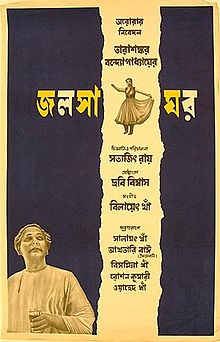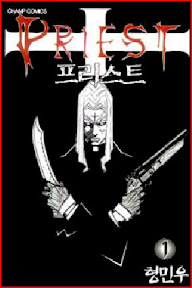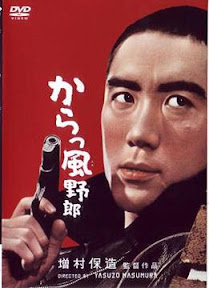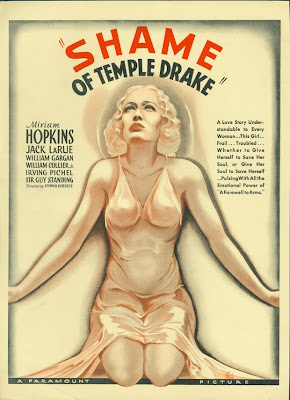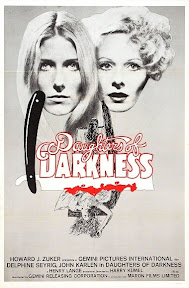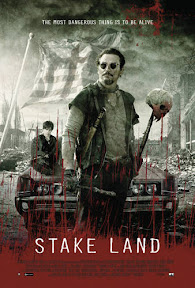 W
While my friend Wendigo is the real vampire-movie fan, he sometimes doesn't know about the lower-profile indy vampire films until I happen to stumble upon them. That was the case earlier this year when I mentioned that a low-budget vamp movie was getting rave reviews down in New York City. He hadn't heard of
Stake Land at that point, and didn't really remember my mentioning it when I showed him the DVD from the Albany Public Library. He isn't automatically impressed by positive notices in The New Yorker or other publications, nor should he be, but he saw no reason not to take a chance on Jim Mickle's apocalyptic vision, and now it's a film he wants to add to his personal collection.
Mickle envisions the fall of America within a generation of the outbreak of some kind of contagion -- he's vague about the cause but biological warfare seems likely -- that turns millions of people into fanged bloodsuckers who die in sunlight. Bad enough on its own terms, the contagion is abetted by a cult militia, the Brotherhood, who believe that the vampires are God's scourge to cleanse the earth. By providing the apparently mindless vampires with victims, the Brotherhood acquires a measure of control over them, and uses them as biological weapons, dropping them from helicopters into secure enclaves ("lockdowns") from small hamlets to Washington D.C. The federal government has collapsed, the politicians have fled or died, and the cities are hopelessly infested. That leaves survivors in small communities to fend for themselves in lockdowns or forge north toward "New Eden" in spite of rumors of cannibalism there. It's a world where lone-wolf hunters like "Mister" (co-writer Nick Damici) have become legends, but have also become a dying breed, and where extracted vampire fangs are trophies and a kind of currency. It's probably a matter of prestige rather than value; if you can show some fangs, particularly the long ones from "berserker" vampires, you can get a lot on the house.
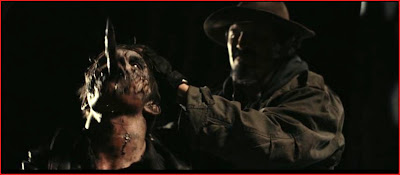
Above, Mister (Nick Damici) plies his trade.
Below, the currency of his trade.
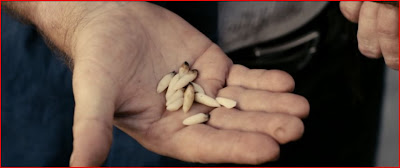
Mister is heading north with his assistant Martin (Connor Paolo), whom he rescued from an attack that left Martin's parents dead. Mister's a hard taskmaster, but you can understand his reasons, though people tend to question whether traveling is a better option than settling down, especially given the dangers in the wilderness where the Brotherhood holds sway. But Mister is a classic restless loner, Martin notwithstanding, and he seems to think that all the lockdowns are doomed, anyway. Inevitably, though, he runs afoul of the Brotherhood when he rescues a nun (Kelly McGillis) from rape and kills the son of local Brotherhood chieftain Jebedia (Michael Cerveris). The trio fall into a Jonestown trap, a feigned mass suicide, and are captured, the nun to become Jebedia's concubine, Martin to be raised by the Brotherhood, and Mister to be left tied up on the road at night as vampire chow. But Mister is not so easily disposed of, and Martin isn't so easily deterred from running away, and after some narrow escapes they leave the nun to her fate and hit the road again.

Mister hunts humans as well, especially rapists, but that puts him in trouble with the hooded Brotherhood
Along the way they hook up with an ex-Marine and pick up a pregnant hitchhiker (Danielle Harris)before taking revenge on Jebedia and reuniting with the somehow-escaped nun (it's really so unbelievable that she got away that we actually thought it might be a dream sequence) in another lockdown. A brief moment of reunions and revelry is ruined by a Brotherhood airdrop. Leaving the lockdown folk to rebuild, our motley quintet ventures out once more, only to gradually discover that they're being stalked by a new kind of mutated vampire -- a "thinker" who proves all too familiar....
A fleeting moment of peace for Connor Paolo and "paranormal expert" Danielle Harris,
with Kelly McGillis barely visible at screen right.
Wendigo and I were strangely reminded of
I Am Legend -- the Richard Matheson novel, not any of the movie versions -- by
Stake Land's vampires and by its otherwise relatively sociable hero. The vamps here are folkloric revenants, little more than hungry corpses without any gifts for seduction, but still sufficiently humanoid that they're scary in a way the animalistic vampires from
Priest were not. There are telling moments in Mickle's film where people recognize their vamp attackers as former neighbors and friends; some of the moments are sad, some sardonically funny. Mickle and Damici put their own stamp on the vamps by introducing different classifications and noting numerous mutations. They create a jargon of labels like "berserkers" (who have longer fangs and tougher breastplates, requiring a stake through the spine) and "scamps," young, confused vampires who haven't quite developed the killer instinct yet. They also try to naturalize the phenomena, by noting that vamps don't flourish in cold climates, while following Matheson in giving them some traditional yet unaccountable vulnerabilities. Following
Priest, this is the second vampire film we've seen in a row that climaxes with the appearance of a "new" kind of intelligent vampire that comes closest to the traditional movie vampire. Wendigo suggests that this possible trend that portrays the traditional master vampire as the product of an evolutionary process is necessary to convince a skeptical audience that a lone humanoid vampire can once again be scary. The "thinker" or "human vampire" is a game-changer, Wendigo contends, changing the rules that the fantasy scenario has so carefully laid down. They're also an admission by writers and directors that the hordelike inhuman vampire really isn't as scary as they sometimes claim.
At the same time,
Stake Land seemed to us at times like
Zombieland played straight, with a violent eccentric training a neophyte and real risk facing any character we get to know. Like in
Zombieland, characters aren't encouraged to dwell on their pasts, and we never learn how Mister became a hunter or got his nickname. There's implicit resignation in this, an admission that there's no point dwelling on the past because it's gone and not coming back. That helps establish the plausibly postapocalyptic setting for a film that's more
Mad Max than
Road Warrior, though Wendigo was reminded even more of the
Walking Dead comics and TV series. So does the enactment of a widely shared American nightmare of a militia cult taking over and imposing a reign of fanatic terror. The Brotherhood are such hateful villains that Wendigo and I were perplexed that the people in the lockdowns didn't join forces to destroy them utterly. But that's societal breakdown for you, I guess, and it may have something to do with Mister's lack of faith in any of the lockdowns. In any event, it's a story of "Red" America against itself, with a bias toward country music even among the good survivors, but we're not sure if there's a message to that.
Stake Land isn't above the occasional festive Romero homage.
Stake Land has a visceral quality that's probably only enhanced by Mickle's obviously small budget. Wendigo could tell whenever Mickle was cutting corners, and we could tell that he was doing so creatively, particularly when he stages the vampire airdrop in the obvious absence of an actual helicopter. You'll also notice that there aren't horde attacks or burning or exploding vampires -- we only see the remains when vamps are left out in the sun. The less obvious fakery, i.e. the less cheap CGI you use, the more convincing the fantasy actually becomes. Most of Mickle's effects budget went to makeup and practical gore effects, though
Stake Land doesn't go overboard with the latter. The real keys to the movie's pretense of authenticity are Mickle's location work and art direction, which set the story in genuinely rundown and rugged settings and occasionally achieve paradoxically pastoral, even idyllic effects, and the committed acting of Damici and the rest of the unglamorous cast. Connor Paolo recovers quickly from his "Call me Ishmael" style opening to play a coming-of-age role in uncliched, unpredictable style. A completely deglamorized Kelly McGillis impresses in her small role as someone barely qualified to cope with disaster who struggles constantly to retain her moral sense. Not even Mister is a generic character, archetypal as sometimes seems. He's not a super slayer, despite his reputation, and he doesn't have all the answers or all the wisdom -- which means he's in as constant peril of making a fatal mistake as everyone else. Like the hero of
The Road, it's possible to say that Mister's go-it-alone approach is the wrong answer for the time, and the ending suggests that Mister himself may have realized this. In fact, the film promises no safety, but insists on no doom, for any of the characters. It ends at a literal liminal point of transition, a border crossing that really stands for nothing but another milestone crossed. It's the happy ending of a day, or a stage, at most, and it's not particularly reassuring. Nor is it meant to be, since
Stake Land is arguably a fall-of-America scenario first and foremost, with the vampires as a Macguffin -- though that doesn't dilute its power as a vampire film very much.
Mickle's movie will be joining Wendigo's permanent collection because it's a carefully crafted, convincing and character-driven fantasy rather than the all-too-common compilation of vampire cliches. In short,
Stake Land creates the illusion of a real world gone terribly wrong. As such, Wendigo says it's the best vampire film he's seen since
Let The Right One In. He recommends it strongly to any vampire fan, and especially to those who, unlike Wendigo himself, are sick and tired of the benign vampire fantasies of
Twilight and the like. He hopes that
Stake Land is a film all vampire fans can agree upon.
 A martial arts or wuxia movie set in snowy locations is as unusual to me as a spaghetti western in a similar setting, but any comparison between Lo Wei's wintry adventure and Sergio Corbucci's The Great Silence must end there. The two films are alike only in their bracing visual novelty, the locations for Shadow Whip enlivening a rather silly story. The mighty Cheng Pei-Pei stars as innkeeper Yun Kaiyun, who lives and learns the art of the fighting whip from her uncle Fang Chentian (Feng Tien). All of a sudden, a chance encounter on the road into town brings all sorts of trouble down on the inn. Two swordsmen and a band of bandits all have grudges with Fang, the man known as "the Shadow Whip," and it's taken all of them 15 years to track him down. Turns out he's been in hiding ever since a big, brazen robbery of a caravan that left its organizer dead, the security firm hired to protect it bankrupt, and the bandit gang severely pissed off. They'd planned to raid the caravan, only to have the Shadow Whip apparently beat them to it, and now they want to avenge his waste of their time. Meanwhile, Fang's onetime sworn brother, who'd asked him to help out guarding the caravan, wants revenge for his betrayal, and the son of the organizer wants plain old blood for blood. But what looks like a tale of terrible discoveries by Yun about her uncle twists into a whodunit when a flashback reveals his innocence. It isn't much of a mystery once Fang himself is off the hook, and it's hard to believe that he's spent 15 years in hiding without ever considering the most obvious possibility. But this is the sort of picture where the real culprit can be tricked into incriminating himself with ridiculous ease, so Feng's stupidity doesn't exactly stand out. Let's concede that the plot is just an excuse for the action and move on to the meat of the picture.
A martial arts or wuxia movie set in snowy locations is as unusual to me as a spaghetti western in a similar setting, but any comparison between Lo Wei's wintry adventure and Sergio Corbucci's The Great Silence must end there. The two films are alike only in their bracing visual novelty, the locations for Shadow Whip enlivening a rather silly story. The mighty Cheng Pei-Pei stars as innkeeper Yun Kaiyun, who lives and learns the art of the fighting whip from her uncle Fang Chentian (Feng Tien). All of a sudden, a chance encounter on the road into town brings all sorts of trouble down on the inn. Two swordsmen and a band of bandits all have grudges with Fang, the man known as "the Shadow Whip," and it's taken all of them 15 years to track him down. Turns out he's been in hiding ever since a big, brazen robbery of a caravan that left its organizer dead, the security firm hired to protect it bankrupt, and the bandit gang severely pissed off. They'd planned to raid the caravan, only to have the Shadow Whip apparently beat them to it, and now they want to avenge his waste of their time. Meanwhile, Fang's onetime sworn brother, who'd asked him to help out guarding the caravan, wants revenge for his betrayal, and the son of the organizer wants plain old blood for blood. But what looks like a tale of terrible discoveries by Yun about her uncle twists into a whodunit when a flashback reveals his innocence. It isn't much of a mystery once Fang himself is off the hook, and it's hard to believe that he's spent 15 years in hiding without ever considering the most obvious possibility. But this is the sort of picture where the real culprit can be tricked into incriminating himself with ridiculous ease, so Feng's stupidity doesn't exactly stand out. Let's concede that the plot is just an excuse for the action and move on to the meat of the picture.